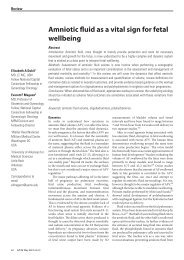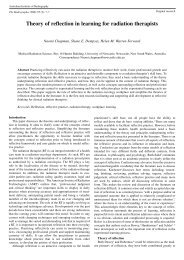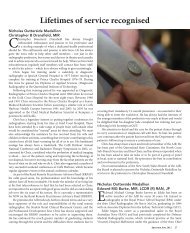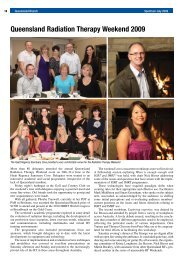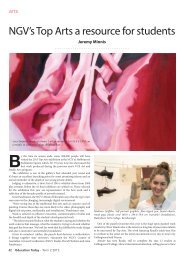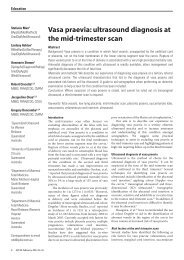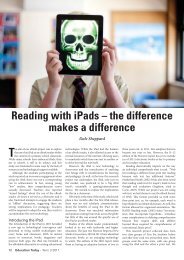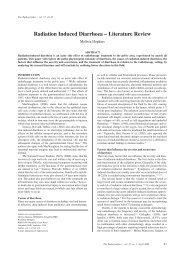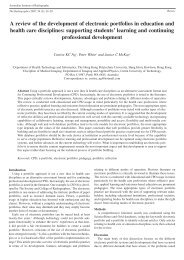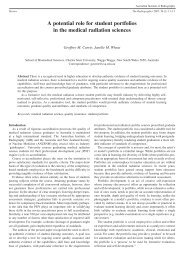Nobel Prize for CT and MRI pioneers - Minnis Journals
Nobel Prize for CT and MRI pioneers - Minnis Journals
Nobel Prize for CT and MRI pioneers - Minnis Journals
Create successful ePaper yourself
Turn your PDF publications into a flip-book with our unique Google optimized e-Paper software.
<strong>Nobel</strong> <strong>Prize</strong> <strong>for</strong> <strong>CT</strong> <strong>and</strong> <strong>MRI</strong> <strong>pioneers</strong>The Radiographer Angeles Times, a few days after the awards were announced.’‘It had been clear <strong>for</strong> some time that there would be a prize <strong>for</strong><strong>MRI</strong>, because of the impact that it has had, but it was not clearwho would be included’ says Stephen Keevil of Guy’s Hospital inLondon. ‘I am sure however, that Lauterbur <strong>and</strong> Mansfield deservethe prize.’ Keevil says that he has some sympathy <strong>for</strong> Damadianbut points out that the prize appears to have been awarded specifically<strong>for</strong> Lauterbur’s <strong>and</strong> Mansfield’s work on the use of magneticfield gradients saying: ‘Damadian has made major contributionsto <strong>MRI</strong> but not in this specific area.’In particular, Damadian’s work was centred on establishing T1<strong>and</strong> T2 relaxation times <strong>for</strong> healthy <strong>and</strong> diseased tissues. In March1972, he applied <strong>for</strong> a patent <strong>for</strong> an ‘Apparatus <strong>and</strong> Method <strong>for</strong>Detecting Cancer Tissue’. Subsequently, Damadian built an NMRimaging scanner that he called the ‘Indomitable’. In 1974, hereceived the patent <strong>and</strong> started a company called FONAR (FieldFocused Nuclear Magnetic Resonance). For this contributionto <strong>MRI</strong>, Damadian received the National Medal of TechnologyAward in 1988 from President Reagan. This award is the highesthonour bestowed by the President of the United States to notableinnovators in the US, see www.technology.gov/Medal/default.htm.Dr Damadian was inducted into the National Inventors Hallof Fame in 1989, <strong>for</strong> his pioneering work. For more in<strong>for</strong>mationon his work, the interested reader should refer to an article inScientific American 3 as well as the following web sites that wereactive at the time of writing this article:www.fonar.com/nobel.htm <strong>and</strong>;www.invent.org/hall_of_fame/36.html.In 1993, an article that appeared in Diagnostic Imaging 4 entitled‘Is there a <strong>Nobel</strong> <strong>Prize</strong> in <strong>MRI</strong>’s Future?’ included variousopinions from several expert scientists <strong>and</strong> radiologists includingLauterbur, Ernst, Young, <strong>and</strong> Smith. From the perspective of theauthor of this brief paper, the opinion of Dr Francis Smith, professor<strong>and</strong> consultant in nuclear imaging in Scotl<strong>and</strong>, providesa reasonable framework <strong>for</strong> awarding the prize. Dr Smith statedthat: ‘If the prize were given on the basis of who was first, thiswould make a mockery of what came afterwards. There are aboutnine key players, but I think that it would be fair if the prize wereshared in three ways: Damadian <strong>for</strong> his ideas, Lauterbur <strong>for</strong> showingthat they were possible, <strong>and</strong> Mansfield <strong>for</strong> further developingthe concept’. 4<strong>for</strong> their work that help physicians diagnose, treat <strong>and</strong> manage awide range of patients’ medical problems.This article serves to impress upon us there is significant valuein the study of not only the physics of imaging but the engineeringaspects as well. These are the many tools we use to produce diagnosticimages, so that our patients can benefit from our wisdom.AcknowledgmentThe author would like to express his sincere thanks to AnthonyChan, M.Eng., M.Sc., P.Eng., C.Eng., C.C.E ; Program Head <strong>and</strong>Faculty of the Biomedical Engineering Department at the BritishColumbia Institute of Technology, Burnaby, Canada; <strong>for</strong> his carefulreview of the manuscript.References1 Bushong S. <strong>MRI</strong>: Physical <strong>and</strong> Biological Principles. Third Edition. 2003;Mosby, Inc.2 Cartlidge E. <strong>MRI</strong> <strong>pioneers</strong> share medicine prize. Physics World 2003; 16 (6).3 Profile of Raymond Damadian. Scientific American 1997; 32–4.4 <strong>Nobel</strong> Mistake? Controversy overshadows recognition of <strong>MRI</strong>’s scientificprominence. Diagnos Imaging 2003; 42–9.Further readingDallessio KM. RSNA Preview; <strong>Nobel</strong> <strong>Prize</strong> awarded <strong>for</strong> discoveries leading toMR imaging. Appl Radiol 2003; 66.Gore J. Out of the Shadows-<strong>MRI</strong> <strong>and</strong> the <strong>Nobel</strong> <strong>Prize</strong>. New Engl J Med 2003;349 (24): 2290–2292.Mattson J <strong>and</strong> Simon M. The Pioneers of NMR <strong>and</strong> Magnetic Resonance inMedicine: The Story of <strong>MRI</strong>. Bar-Ilan University Press 1996.Ritter M. Doctors win <strong>Nobel</strong> <strong>Prize</strong> <strong>for</strong> <strong>MRI</strong> discoveries. Vancouver Sun. 2003;October 7th: A7.www.nobel.se/medicine/laureates/2003/lauterbur-cv.htmlwww.scs.uiuc.edu/chem/lauterb.htmwww.beckman.uiuc.edu/faculty/lauterbu.htmlwww.nobel.se/medicine/laureates/2003/mansfield-cv.htmlwww.nottingham.ac.uk/~ppzwww/staff/Mansfield_P_t.htmlwww.magres.nottingham.ac.uk/~mansfield/www.technology.gov/Medal/default.htmwww.fonar.com/nobel.htmwww.invent.org/hall_of_fame/36.htmlConclusionIt is interesting to note that the <strong>Nobel</strong> <strong>Prize</strong> <strong>for</strong> Physiology orMedicine has been awarded to physicists, chemists, <strong>and</strong> engineers,



